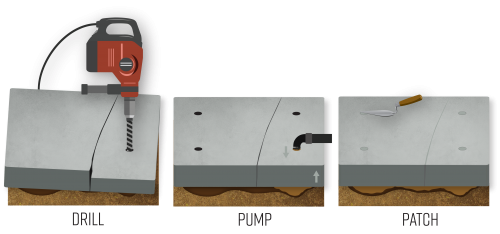Mudjacking or slab jacking is a method for lifting and leveling sunken concrete. Over time, sidewalks, driveways, patios and even commercial floors can settle or sink due to soil erosion, poor compaction or water infiltration. Mudjacking addresses this by injecting a slurry mixture beneath the concrete to fill voids and lift the slab back into place.
With over 50 years of experience, HMI provides advanced concrete lifting equipment and support to help contractors and business owners master this process. Here, we will address what you need to know about mudjacking, the equipment you’ll need for success and what you can expect regarding longevity.
Benefits of Choosing Mudjacking for Concrete Repairs
Concrete leveling mudjacking is a wise choice because it reduces downtime. Several small holes are drilled into the slab, and the material is pumped in with a mudjacking pump. Once the voids are filled, the concrete is raised, stabilized and ready for use in a fraction of the time compared to concrete replacement.
Mudjacking is also environmentally friendly. By restoring existing concrete, you avoid the environmental impact of concrete demolition and disposal, which can help your business focus on its sustainability initiatives. Many professionals find that mudjacking procedures are effective in diverse locations, including but not limited to:
- Sidewalks
- Curbs
- Roads
- Stairs
- Driveways
- Pool Deck
- Patios
- Floors
- Loading docks
- Roads
- Bridge approaches
- Off or on ramps

Reduce Expenses With a Concrete Replacement Alternative
With concrete demolition and cleanup efforts, there are several expenses to consider.
Crews need to visit the site, break up surfaces with jackhammers, transport the broken concrete to a collection bin and repeat the process until the surface is clear. This portion of a project often demands heavy equipment like excavators and skid steers, as the sections of broken concrete are too heavy to lift by hand. You then need the material and equipment to restore the site by pouring concrete mixtures and ensuring everything dries correctly.
The required training, permits, labor and resources involved with demolishing and replacing concrete far exceed those required to lift concrete surfaces using a mudjacking pump. When surfaces are in a workable condition, mudjacking concrete has the potential to save you thousands. You can complete multiple mudjacking jobs in the time it would take to completely replace concrete slabs at one project site.
The Mudjacking Process for Concrete Repairs
Mudjacking procedures for concrete repairs enable you to lift and stabilize slabs. With the proper training, crews can use a mudjacking pump to inject a slurry of sand, soil, water and cement into predrilled holes. The mudjacking process is similar to polyurethane injections, except you must drill holes in slabs that are between 1 and 2 inches in diameter.
You can complete a series of injections and watch the sunken concrete lift several inches in the matter of minutes. HMI recommends adding a small amount of slurry into each hole to avoid overfilling. Injections can be completed within a few minutes of each other for a quick project turnaround. Once you are satisfied with the leveling results, the drilled holes should be patched with concrete for an aesthetically pleasing appearance.
With HMI’s cutting-edge tools like the EliteONE Air Purge Gun, contractors can improve efficiency and even revisit injection points when needed — something traditional mudjacking systems can’t match as easily.
Sign up for Our Upcoming Discovery and Training Seminars
If you’re curious about getting into the business of concrete leveling, mudjacking or learning about modern alternatives, HMI offers in-depth training sessions. These classes cover everything from operating equipment and estimating jobs to marketing your services. Register today and start learning how to take your operations to a new level.
FAQs
How long does mudjacking last?
Mudjacking concrete slabs has the potential to last for several years. Factors such as soil conditions and how water drains from landscapes contribute to a repair’s longevity. Concrete slabs can settle again over time if serious problems regarding soil are not addressed in a timely fashion.
Is mudjacking better than foam lifting?
There is a time and place for both polyurethane injections and mudjacking. Foam lifting offers several advantages, including lighter-weight materials, faster cure times and greater precision. Mudjacking projects are generally less expensive than polyurethane foam injection work and can be cost-effective.
Are there any problems with mudjacking?
Mudjacking material is heavier and can sometimes contribute to future settling if the soil beneath is unstable. It requires truck material and mixing a mud slurry on site. It also requires larger drilled holes compared to foam lifting, which can be more invasive.
Is mudjacking a permanent fix?
Mudjacking is a long-lasting repair, but it’s not always permanent. The longevity depends largely on site conditions and proper water management. Polyurethane foam systems, like those offered by HMI, provide a more durable alternative in many cases.

